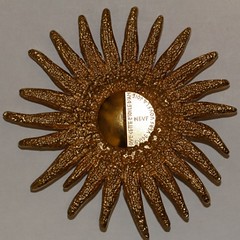
PREV ARTICLE
NEXT ARTICLE
FULL ISSUE
PREV FULL ISSUE
VOCABULARY TERM: MEDALLIC OBJECTSDick Johnson submitted these thoughts on a medal owned by Byron Weston (see
previous article). Thanks! -Editor
This medal is Star of Joy. It was chosen as the tenth in a series of medals as the special examples from the Paris Mint's General Collection. It displays the sun in the center and 24 rays (these are not arms as we might be wont to call them) they are sun rays. The sun as center is smooth, polished, and contains the lettering. In contrast, the texture of the rays is style rude, an artistic term meaning rough style. A numismatist would be more apt to call it "rugosity." QUICK QUIZ: What 20th century U.S. circulating coin did Walter Breen describe as displaying rugosity? This medal falls in the category of numismatic items called medallic objects, a term created by the Paris Mint, as the title of their 1985 catalog, la Medalle-Object. This catalog was the forerunner and displays the foremost collection of these new art objects. Medallic objects are the modern art of medals. I once called them bas-relief unleashed, since coins and medals are made from bas-relief models. But that's about as close as they come to traditional numismatic items. They do not have the restrictions of coins, nor the limits of medals. They allow their creator's imagination to run wild and express this in medallic form. Medallic objects can be struck, but more often are cast. Casting allows them to have unlimited shape, open areas, and freedom of design. Recently they have taken on fabrication of mixed media - metal and other compositions - and multiple parts. Fabrication is a key word here as more are assembled from separate parts, often for a contrasting color effect. Medallic objects allow their creators more than freedom of design. After all, they are the modern art of the medallic field. And their creators' imaginations do run wild! But this lessens their appeal, it seems, as numismatic traditionalists want only coin or coin-like objects. They appeal more to art collectors, or advanced numismatists interested in art. I have written extensively on medallic objects. When the international organization of medallists (FIDEM) met at the ANA headquarters in Colorado Springs in 2007 I wrote what I hoped would be the introduction to the Exhibition Catalog. Instead the editors boiled it down to an article in the The Numismatist with some fine medallic illustrations. ANA gave every attendee a copy as well as the organization's members in their monthly magazine. "Objects of Desire" appeared in the September 2007 issue of The Numismatist. The best part was edited out, however. I claim that America invented medallic objects. For Christmas 1965 Art in America magazine wanted a unique promotion. Their management commissioned a curator at the Museum of Modern Art, Edward Albert Bryant, to create something unique. Bryant contacted William Louth of Medallic Art Company and the two of them developed the concept of having seven modern art sculptors create miniature works of art that could be reproduced. They picked top artists in the field and commissions went out to Chryssa, Ernest Trova, Roy Gussov, Elbert Weinberg, Harold Tovish, James Wein, and Constantino Nivola. Response was excellent for the quality and artistic distinctiveness of their creations. Medallic items, large galvanos and two small pins -- in addition to medallion size items -- were offered by Art In America in time for 1965 Christmas gifts. That fixed the date as the first medallic objects ever, created by seven Americans! The Paris Mint issued their first medallic objects in June 1966. This opened the gate for artists all over the world to create medallic objects. To their credit, the Paris Mint encouraged artists to submit models, virtually underwriting the new media. By the early 1970s the Paris Mint was issuing as many as one new medallic object a day! This was particularly true under the administrating of Pierre deHay (about whom I wrote recently in The E-Sylum). Unfortunately, Americans could not match this pace. One stands out in my mind, however: Salute to Airmail by Roy Lichtenstein in 1968. Meanwhile, a new organization was established in America, the American Medallic Sculpture Association. AMSA members quickly adopted the new medallic media. As George Cuhaj (onetime AMSA official, author and Krause publication editor) said in a recent exhibition catalog entry, "I could do this" as he viewed what early members were creating. Since then he has created more than thirty medallic objects. Among traditional medals are found medallic objects in every exhibition of AMSA, and also of the international organization of medallists (FIDEM) created by artists around the world. While artists like the new media. now 50 years old, medal collectors have yet to embrace it in large numbers. While Byron Weston embraced his new find -- its shape can best be described as "unusual shape" to answer his question -- he has discovered a new numismatic media to collect. I wish others would follow as well. To read earlier E-Sylum articles, see:
THE BOOK BAZARREWayne Homren, Editor The Numismatic Bibliomania Society is a non-profit organization promoting numismatic literature. See our web site at coinbooks.org. To submit items for publication in The E-Sylum, write to the Editor at this address: whomren@gmail.com To subscribe go to: https://my.binhost.com/lists/listinfo/esylum All Rights Reserved. NBS Home Page Contact the NBS webmaster 
|
